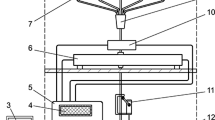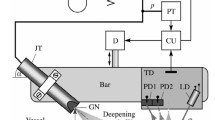A sensor for precise measurements of low flow rates of specialized liquids, including medical liquids, is developed. Through the use of the sensor, it is possible to automate the process of precision dosing of liquids in real time.
Similar content being viewed by others
Avoid common mistakes on your manuscript.
Special attention is now being paid to the problem of increasing the efficiency and precision of measurements of the rate of flow of liquids [1–3]. Precision in the measurement of low flow rates of liquids is of great importance in the chemical and biochemical branches of industry and in medicine, for example, for measurements of the rates of flow of solutions of medicines in infusion systems, liquid chemical substances, including catalysts and titers when dosing medicinal compounds, solutions, etc. [4].
Existing methods of measurements and devices for implementing these methods [3, 5–7] suffer from a number of drawbacks, for example, large overall dimensions of the devices and the complexity of their construction, low precision of measurements of low flow rates of liquid, and low sensitivity. In addition, with the use of the contact method of measurement, which is employed in practically all devices, a sensor cannot be employed in corrosive and toxic media. These drawbacks reduce the precision with which low liquid flow rates are measured and limit the range of application of the sensors.
A measurement instrument by means of which high precision may be achieved and, at the same time, an output signal from the sensing element transformed for subsequent processing, analysis, and generation of control actions is needed for automatic control of the rate of flow.
A sensor [8] of low liquid flow rates (Fig. 1) has been developed to realize precise measurements of low flow rates of specialized liquids. The sensor consists of a case 3 with opaque covers 1, 14 within which mounting screws 2, 13, lens mounts 4, 12, and plates with slit-like horizontal slots 5, 11 are installed. A transparent element 8 is situated in an opening 22 perpendicular to the axis of the case 3. A source of radiation (laser light-emitting diode) 20 with leads 21 is placed in mounting screw 2 while a photodetector (optoelectronic transistor or photodiode) 16 with leads 15 is placed in mounting screw 4. A scattering lens 19 designed in the form of a glass cylinder is mounted in lens mount 4 and a collecting lens 17 in lens mount 12. The translucent element 8 is supplied with an inlet 9 and outlet 18 for liquid and a drop former 10. The two lens 17 and 19 and the two plates with slit-like horizontal slots 5 and 11 form an optical system 6 that transforms the light flux from the radiation source 20 and creates a measurement plane 7 within the transparent element 8.
Sensor of low liquid flow rates with cylindrical transparent element: 1, 14) opaque covers; 2, 13) mounting screws; 3) case; 4, 12) lens mounts; 5, 11) plates with slit-like horizontal slots; 6) optical system; 7) measurement plane; 8) transparent element; 9, 18) inlet and outlet, respectively; 10) drop former; 15) photodetector; 16) photodetector leads; 17, 19) collecting and scattering lens; 20) radiation source (laser light diode); 21) leads of radiation source; 22) opening.
The diameter of the transparent element 8 must be at least three times the diameter of a drop of the liquid being measured and must be greater than the length of the slots in plates 5 and 11. The length of the slot in plate 11 is slightly greater than the length of the slot in plate 5. The length of the slots in plates 5 and 11 is less than the diameters of the scattering 19 and collecting 17 lens.
To increase the measurement precision, the height of the slot in plates 5 and 11 must be decreased and the length of the slot in plate 11 must be made commensurable with the projection of the shadow of a drop of the liquid. Relative displacement of the slots is not permitted, since this would lead to a reduction in the sensitivity and precision of the sensor.
The low liquid flow rate sensor functions in the following way. As it passes through the scattering lens 19, light beams from the source of radiation change direction, becoming nearly parallel and turn into a light flux. Passing through the slot in the plate 5, the light flux then assumes the form of a measurement plane that passes through the transparent element, partially refracting and scattering on the walls. Once a drop that has been created by the drop former falls on the measurement plane, the light flux is distorted and its intensity falls. After traversing the transparent element, the light flux passes through the slot in plate 11 and the collecting lens 17. This makes it possible to focus the light flux in the form of a beam, which guarantees it will reliably fall on the photodetector’s photosensing element. Because of the presence of the slot in plate 11, scattering of the light flux in the vertical plane can be eliminated, which makes it possible to create additional irradiation of the photodetector, which worsens the metrological characteristics of the device. The system of opaque lens mounts and plates 5 and 11 promotes nonpropagation of the light flux from the radiation source into the entire volume of the sensor case as well as its precise focusing.
Pipes lead to the inlet and outlet 9 and 18 of the element 8. Liquid from the inlet in the form of drops created by the drop former pass through the measurement plane of element 8 and are drained through outlet 18. A signal from the measurement plane in the form of a distorted light beam falls on the photodetcctor 16 and is transmitted to an analog-to-digital converter, where it is transformed into the liquid flow rate.
The thickness of the plates with slots 5 and 11 is selected from the condition:
where h p is the thickness of plates 5 and 11; λ, wavelength of source of radiation; H d, drop height of liquid drop; v d, rate of fly-over of drop; and t ADC, total conversion time of analog-to-digital converter.
A number of conditions must be observed in the course of calculating the volume of a drop V d to assure a high degree of precision of measurement of the volume of a drop:
where U 0ADC is the normalized signal of the photodetector; U ADC, the photodetector signal in measurement of a drop at a particular moment of time; k, correction factor of volume; and m, total digitization number of signal.
In addition,
where D d is the projection of the shadow of a drop in the field of vision of the photodetector, and L p is the length of the plate with the slot.
From (1)–(3), it follows that, in order to increase the measurement precision, the thickness of plate 5 must be decreased and the length of plate 11 made commensurable with the projection of the shadow of a drop.
Today there exist a number of different methods of infusion introduction of medicines into the patient’s organism, where the rates of introduction of the medicine differ and are determined by special requirements. The simplest and least expensive method of introducing medicines is by means of drop infusion systems. In the newly developed device, the drop chamber of an infusion system corresponding to the standard [9] mounted in the conical opening of the case [8] may function as the transparent element with a measurement plane, drop former, and inlet and outlet. This makes it possible to expand the range of application of the sensor and use it, for example, in medicine to monitor the flow rate of liquids and the flow of blood and its components.
With such a design, the device executes the following functions: measurement of the quantity of released drops; determination of the rate of dosing of a solution; diagnosis of the operation of a drop system (variation in flow of liquid, overflow of drop chamber, etc.); and prediction of the time when infusion has been completed. By comparison with existing devices, the use of the proposed device produces an increase in the precision with which low liquid flow rates are measured, achieved by an increase in the number of discrete transformations, as well as the values of signal digitization as a consequence of the use of an optical method of measurement. An expansion of the range of measured values of low liquid flow rates is also achieved.
Because the measurement plane is created within a transparent element that is not in contact with the optical system, a contactless method of measurement can be realized, which significantly expands the range of application of the sensor and makes it possible to use it for measurement of low flow rates of practically any liquid, including in corrosive and toxic media.
The use of the newly developed device for measurement of low liquid flow rates creates conditions for complete automation of the process of precision dosing of different liquids, including medical liquids, and makes it possible to manage the dosing process in real time.
References
M. B. Gutkin, V. I. Mishustin, and Yu. A. Chistyakov, “The metrological backup for measurements of the flow rate and volume of liquids and gases,” Izmer. Tekhn., No. 3, 30–34 (2010); Measur. Techn., 53, No. 3, 281–287 (2010).
L. A. Adamovskii, “Vortex electromagnetic flowmeter-counter for liquids with ionic conductivity,” Izmer. Tekhn., No. 11, 32–39 (2008); Measur. Techn., 51, No. 11, 1191–1199 (2008).
Yu. V. Zorin and I. Yu. Eremin, “Increasing the precision in measurement of the flow of petroleum in the case of deformation of a pipeline,” Izmer. Tekhn., No. 1, 43–44 (2013); Measur. Techn., 56, No. 1, 61–64 (2013).
K. O. Alekseev, “Typical features of measurement of the flow rate of biological fluid in hemodialysis machines,” Izmer. Tekhn., No. 11, 68–71 (2010); Measur. Techn., 53, No.11, 1292–1298 (2011).
V. I. Litvak, Photoelectric Sensors in Management, Control, and Regulation Systems, Nauka, Moscow (1966), pp. 289–290.
A. A. Ivashkin and V. P. Konarev, Patent No. 2035720 RF, “Liquid flow rate sensor,” Izobret., No. 5 (1995).
I. S. Konstantinov, Yu. V. Kas’yanov, and A. I. Suzdal’tsev, Patent No. 2247328 RF, “A device for measurement of the flow rate of a liquid,” Byull., No. 6 (2005).
V. P. Zayarnyi, I. V. Volkov, A. M. Makarov, and Yu. P. Serdobintsev, Patent No. 136564 RF, VolgGTU (2014).
GOST 25047–87, Complete Single-Use Exfusion, Infusion, and Transfusion Devices.
Author information
Authors and Affiliations
Corresponding author
Additional information
Translated from Izmeritel’naya Tekhnika, No. 7, pp. 35–37, July, 2014.
Rights and permissions
About this article
Cite this article
Volkov, I.V., Zayarnyi, V.P., Makarov, A.M. et al. Contactless Measurement of Low Liquid Flow Rates. Meas Tech 57, 783–786 (2014). https://doi.org/10.1007/s11018-014-0536-7
Received:
Published:
Issue Date:
DOI: https://doi.org/10.1007/s11018-014-0536-7





